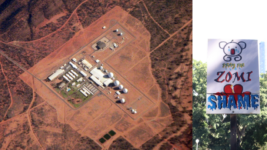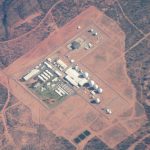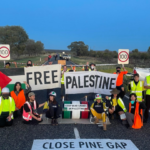Questions Need Answering on Pine Gap and Gaza: Interview With Professor Richard Tanter

Senator Raff Ciccone asked Australian Signals Directorate director general Rachel Noble whether she could clear up the confused social media chatter regarding how Pine Gap-sourced intelligence might be feeding into the Gaza genocide, or in using the official parlance, the “Hamas-Israel conflict”.
During the 14 February Senate estimates exchange, Noble referred the Labor senator to the “extensive body… of information in the parliamentary record” related to Pine Gap. So, he then asked if the chatter was “uninformed speculation”, but the head spy too chose not to comment on that.
The Joint Defence Facility Pine Gap is a US-run surveillance base situated just 18 kilometres southwest of Alice Springs in the centre of the continent. Pine Gap began operations in 1970, and it, along with another top-secret US facility at North West Cape, have always been shrouded in secrecy.
So, Ciccone turned his attention to the Australian government policy of full knowledge and concurrence, which is the approach it takes to Pine Gap and North West Cape, in order to avoid loss of sovereignty when the US is operating in ways it’s not being fully transparent about.
Noble said she’d explain the concept with the aid of the definition that deputy PM Richard Marles put on the table in February 2023, which defines full knowledge as complete understanding of “any capability or activity with a presence” here, or any “making use of Australian assets”.
Marles then added that “concurrence means that Australia approves of the presence of a capability or function in Australia, in support of mutually-agreed goals”.
Complicities mounting
But when Nautilus Institute Professor Richard Tanter delivered a presentation on Pine Gap and Gaza during a 27 March webinar, what he discussed went well beyond the realm of “uninformed speculation”. Indeed, the academic made clear that a lot is actually known about the facility.
A key point the professor raised in relation to the current quandary regarding Pine Gap and Gaza is that it is known that in October 1973, Pine Gap-derived satellite intelligence was passed on to Israel to assist in the Yom Kippur War, which allowed it to break through Egyptian lines in the Sinai.
The hundreds of viewers present at the March Zoom event underwent a collective shock when Tanter presented a number of facts relating to the current crisis, which included three of Pine Gap’s four satellites completely covering the Gaza Strip in their range.
The implications at that point in time were that a surveillance base in Australian jurisdiction had potentially been supplying data to assist in a genocide, which has seen around 35,000 Palestinians, the overwhelming majority of whom were civilians, killed.
Since the webinar, however, the planet has learnt that the Israeli military murdered seven foreign aid workers, including Australian Zomi Frankcom, and the “uninformed speculation” of internet chatter is now stuck on the question of whether Pine Gap might have been involved in that atrocity.
Sydney Criminal Lawyers spoke to Nautilus Institute Professor Richard Tanter, who, in conjunction with ANU Professor the late Desmond Ball and Canadian signals intelligence researcher Bill Robinson, produced the eight research papers making up The Pine Gap Project.
Professor Tanter, during your presentation at the 27 March Pine Gap and Gaza webinar, you implied that the joint facility close by Alice Springs is a partially open secret when compared to other US bases.
But if you read online about the facility, what’s usually stated is it deals with signals intelligence, which leaves many unclear as to what that actually means.
You spoke of signals intelligence and electronic intelligence coming out of Pine Gap. And you then drilled in on that, specifying things like telecommunications, but to me, that then sounds like thousands of text messages and phone calls all at once.
So, what does this all mean? What is signals intelligence? How specific can such information at Pine Gap get, in terms of phone calls and things like that?
I will step back briefly one level from your question and then come back to it. Pine Gap is involved in two kinds of signals intelligence: two quiet separate systems.
It’s important to remember it’s also involved in a wholly different set of space-based surveillance, not of anything electronic, but of the infrared thermal signals of missiles being launched.
That third element, of which I won’t talk about today, gives the Americans early warnings of missile attacks and also for Australia for certain purposes. But let’s leave that aside.
In terms of signals intelligence, the original reason that Pine Gap was established back in 1966, becoming operational in 1970, was to listen to two kinds of signals intelligence.
Firstly, famously and controversially, it was built by the CIA to listen to one particular type of electronic transmission, which was in fact machine talk.
This was machine talk from missiles that the Soviet Union was launching from Central Asia for testing purposes and the missiles were sending back data to the test centres, saying the missile is proceeding at such-and-such a speed and at such-and-such an altitude and consuming fuel at such-and-such a rate.
This was important data for the Soviet engineers to work out how to get right for the next time.
But also, as far as the CIA was concerned, it was extremely important information to work out the capability of new Soviet missile systems, and, of course, then the Americans built something to match them.
At the same time, it had other capabilities, in particular, what the Americans call communications intelligence, which isn’t machines talking to each other, but rather intelligible communications, and, of course, the most important version of that is a military or air force radio.
In both cases, in terms of electronic intelligence, sometimes called technical intelligence, and communications intelligence, you have two separate problems: at least two problems that Pine Gap tries to solve.
One is: can you actually intercept the information? And the second is: can you process it to make sense of it? A third issue that also arises with electronic intelligence and communications intelligence is: is it encrypted, and can you then decrypt it?
Pine Gap has two different versions of this. One is satellite-based: in particular four very large American signals intelligence satellites spread across the equator, roughly sitting in the western Pacific through to the Indian Ocean.
They have huge antennas onboard, which pick up very faint signals from the earth, which can include cell phones, and it certainly includes satellite phones, military radios of all kinds and radars.
If the Americans want to know if they are going to mount an attack on, let’s say, China, or, as they did on Iraq, there are the other side’s air defence radars, which they want to locate, characterise and jam, in order to help the air force destroy them, if they can.
Then the second signals capability that Pine Gap has had for the last 25 years is possibly the reverse of that space-based intelligence.
Instead of giant antennas on satellites in the sky picking up all kinds of transmissions from the ground, this is the reverse, with very large antennas on the ground at Pine Gap, pointing to other countries’ communications satellites.
So, if you call your mate in New York, some of the transmissions might go by optical capable, but other parts will go up to a communications satellite and then be bounced down.
So, what this ground-based part of Pine Gap can do – and it has companion stations operating on behalf of the NSA in New Zealand, in Oman, as well as in Cyprus and the UK – is it listens to the down mix from those phone transmissions and internet transmissions that are within their footprint.
Signals intelligence refers to the interception of any kind of electronic transmission, ranging from radars or machines or computers talking to each other, through to telephone conversations, internet transmission via satellite, satellite phones and so forth.
So, how specific can it get? Pine Gap doesn’t operate alone, so the Pine Gap space-based system on satellites are firstly trying to detect transmissions, say, satellite phones, secondly they’re working together from one satellite to another, trying to triangulate the transmission to get the position of it, which could be an antenna you might find at an internet cafe, that it locates and then, of course, it tries to work out content.
Edward Snowden taught us a vast amount about this. It is all complicated by the fact that a lot of these transmissions don’t go through space, they go through optical fibres and the NSA spends a lot of time intercepting those, but a huge amount still goes via satellite.
So, for example, I was just reading the other day in Iceland, where they have a whole lot of problems with optical cables because of seismic tremors, as they have volcanoes and eruptions going on, and they have just built a microwave transmission tower.
That’s one of those towers we see every 30 or 40 kilometres through parts of the country, which operate along a line of sight from one tower to the other. But, of course, that line of sight from one part of the world goes up into space and can be picked up by a satellite antenna.
And from there, what can be picked up at the joint facility?
Everything from any kind of military radio being used, depending on the frequencies, any kind of satellite being used, again, depending how well it’s encrypted, any kind of telephone connections that go through microwaves, or any machine transmissions, computer-to-computer, by microwaves.
If one of the satellites that Pine Gap controls is in the right position, it can intercept and form usable intelligence out of all of that.
Since your presentation, Australian aid worker Zomi Frankcom and six other aid workers were systematically hunted down by drones and killed by the Israeli military.
I spoke to Wage Peace’s Margaret Pestorius in 2017, after she and some other Peace Pilgrims had successfully broken into the grounds of the Pine Gap facility, in order to shine a light on its involvement with US drone operations.
So, how does Pine Gap facilitate US drone operations?
Margret Pestorius not only broke into Pine Gap in 2016, but she was part of the team that supported four people who broke in almost a decade earlier, including her husband, Bryan Law.
At that time, they claimed Pine Gap could be assisting in operations in Iraq and Afghanistan, and I was asked to be an expert witness in their trial around 2007.
In preparing for the trial, we realised there were some things that we hadn’t before taken into account, and in particular, that was the arrival at Pine Gap of American military units.
So, not the NSA or the CIA, but part of the air force. Then, eventually, there were army, navy, air force and marines.
In other words, we discovered that Pine Gap was deeply involved in supplying usable data for actual military operations, and accordingly, every service had a unit there.
Secondly, we became aware that there were new antenna facilities. Back in the 1970s and 80s, there had always been two main functions of Pine Gap: the CIA’s preoccupation with Soviet missile testing and also, the air force wanting communications intelligence.
But in 1980s and 1990s Washington, there had been a huge series of bureaucratic fights, and essentially, the NSA, which had always been the biggest American intelligence agency – the premier signals intelligence agency – muscled in on the CIA and said, “Look, this is ridiculous. We are spending a vast amount of money on this, so we need more out of it.”
Pine Gap always had a communication’s intelligence role, but that exploded with the militarisation of Pine Gap.
So, in terms of the point Margaret was raising on drones?
Well, Pine Gap has been extremely important in American drone operations, in particular, Pine Gap signals intelligence has been.
That information mixed together with what they find out from human intelligence sources and what they find out from overhead imaging satellites is all mixed together to provide the geolocation, the content and to, as they say, characterise, who is making a phone call, who is making a satellite connection, who is talking on an internet connection, and that data becomes a critical step in the formation of the targeting list either in the Pentagon or the White House.
We know that in the Obama administration, in particular, this information was considered up to the level of the White House.
Pine Gap is a very important source of data, which feeds into those drone operations, both in war in which the United States, and perhaps Australia, is legally a party, as in Afghanistan, until recently.
But also, of course, this involves what are quite properly referred to as extrajudicial executions by the United States, in countries with which neither the United States or Australia are at war, and that now, I suspect, could include Gaza.
What sort of implications could the facility have on something like the strike on Zomi Frankcom and her World Central Kitchen colleagues?
So, communications intelligence is principally what Pine Gap is concerned with now.
To go to the killing of those aid workers, there are three ways that I think signals intelligence could be relevant.
But a second thing is, in each case, as to whether Pine Gap or some other NSA signals intelligence platform was involved, we don’t know.
The potential three ways involve, firstly, whether Israel used Pine Gap-sourced intelligence that came to it via the NSA, as any part of that decision to attack that aid convoy.
So, for example, we know the Israelis said that there weren’t just aid workers there. They said one other person was there and they used the phrase “a person of suspicion” and that was the justification for the attack.
So, the question for the Israeli government and the American government, as I believe the Australian government wouldn’t really know, is whether any Pine Gap-derived intelligence was important to the operation?
The second question is, after the fact, when the Israelis gave their explanations, it was pretty clear that both the American government and the Australian government were dissatisfied.
So, the question then becomes, whether Pine Gap-derived intelligence was used by the American government to assess what happened, and in particular, the veracity of claims made by the Israeli government.
But we don’t know the answer to that.
Thirdly is whether the Australian government is aware of any Pine Gap-derived intelligence information having any role in the killings of those aid workers.
I don’t know the answer, but I could certainly see ways in which it could have been.
For example, in one of those three vans, somebody was using a satellite phone. Satellite phones uplink to a telecommunications satellite and then goes down.
The uplink may have been picked up by a satellite operated by Pine Gap, or it might have been picked up by one operated by the Brits.
They have got another four satellites that are closely relevant to this, but either way, are part of the same system.
Australia can ask the question to the Americans and to the Brits, “Do you know anything? Did something come from us there? Can you tell us?”
That seems to me a fundamental question that we need to ask of the Australian government. And I suspect that in large part, the Australian government doesn’t actually know the answer, at the moment, anyway.
It could find out, but I don’t think it has the answers to hand.
Okay. But, as you said, it’s the same system.
Yes. All of these systems, space-based and ground-based signals intelligence, all operate whether at Pine Gap or at Menwith Hill or in Oman or in Cyprus, these space-based ones all come under NSA auspices.
Menwith Hill, in the UK, is almost wholly an NSA facility. On Menwith Hill and Pine Gap, if you just look at the job ads that come up week after week, they often have you working at Pine Gap and at Menwith Hill, or at one station in cooperation with the other.
They are linked technically by optical fibre, as entirely, you’d expect. They swap data. They swap tasks.
All of the product from all of those stations goes to the NSA. So, it’s an American-paid-for global signals intelligence operation that we’re part of.
Pine Gap and North West Cape mark very early US inroads into Australian jurisdiction.
Over the last 15 years, there has been further significant movement since Obama’s pivot to Asia, which included the force posture initiatives sanctioned by Gillard and Abbott, and now, more recently there’s AUKUS.
How does this all tie in together, in your opinion?
For the last 50 years and more and still today, the most important contribution Australia makes to the American alliance is Pine Gap, followed on by some of the other facilities, including North West Cape.
North West Cape, incidentally, is not just a naval communications station to communicate with submerged submarines, especially American nuclear ones, but also, it now has two huge new facilities.
These involve a space surveillance radar and a space surveillance telescope, which, simply put, are becoming critical to American space warfare operations. The intelligence side of this is greatly expanding.
Secondly, as has always been the case, the Americans have been happy to have the contribution of the Australian military to their wars in Korea, Vietnam, Afghanistan, Iraq and so forth, but what they really value is the contribution that these intelligence facilities make.
From there, you mention the Force Posture Agreement and AUKUS. And there is a great deal that we don’t know about the Force Posture Agreement that was signed in 2014, including which Australian Defence Force facilities are covered by it.
There is a list, but that list is classified, and has not been revealed. And it is important to note that in other countries in the same situation, the host governments have insisted on that list of bases being revealed.
So, for example, in Poland, which is a pretty important American ally at the moment, the bases are known, while we keep it a secret.
The most important example of the Force Posture Agreement are the activities of the marines out of Darwin, and a cluster of bases near Darwin, and also the aviation part of that Darwin-centred expeditionary force: that’s really what it is, it’s to project power.
But very soon, we’re going to have B-52 bombers, including nuclear-capable B-52 bombers, on what the American’s are calling rotational deployment to a RAAF base at Kathrine, RAAF Base Tindall, and that is a huge step in our alignment with America.
So, both the intelligence facilities, and now force projection capabilities, are bringing us much closer into American global strategy, in other words, long-range, long-term, including nuclear capabilities, but also, conventional military capabilities, especially today, about China.
Professor Tanter, lastly, your presentation involved discussing the information you sent to the Inspector General of Intelligence and Security (IGIS), calling on them to investigate Australian complicity in the Gaza genocide, via the input being generated at Pine Gap.
What would you like to come out of your IGIS complaint and what do you expect to come out of it?
I expect the Inspector General of Intelligence and Security to review the complaint that I have made properly and carefully.
They have the capacity to initiate a review, and it will probably have to be a very substantial review to find out the answers to the questions, which they could probably get a general answer to pretty quickly.
It is possible that the lawyers on the government’s side, either in the IGIS itself, or in the Attorney General’s Department, will seek to have a national security certificate imposed which will essentially mean it will not be allowed to be released and reported on, with that national security coverage.
I made the point in my complaint that I could understand that there are some national security matters, but everything that I talked about and everything that my colleagues Bill Robinson, Des Ball and I, have talked about in our publications comes from publicly available sources.
There is certainly nothing involved that the Chinese and the Russian governments don’t know about from their own sources.
But that security justification is also unreasonable.
In Senate estimates in February, the director of the Australian Signals Directorate, Rachel Noble, was asked the question about exactly the connection between Pine Gap and Gaza and she declined to answer it, on the grounds that the intelligence agencies do not comment on operational matters.
There is some reason behind that, if someone was talking about a particular operation that might reveal the exact wavelength, the exact sensitivities of a particular satellite, that may be something that might be considered.
But this is far beyond the level of operations. This is a matter of high government policy. We’re talking about something that hasn’t just happened on one day, but has probably happened on many, many days, over a number of decades.
As we know this has been going on since 1973. It is a matter of policy. And I expect it is reasonable that the inspector general and the attorney general will deal with this as a matter of policy.
If we can’t think about the inspector general taking out a reasonable case about the possible complicity of Australia in genocide seriously, and looking at it seriously and considering with due respect for proper security matters, if we can’t think about that in respect of genocide from the World Court, the highest court in the world, what can we expect from the government’s idea that “we have full knowledge and concurrence” of what happens at Pine Gap?
Do we have full knowledge? I suspect not, in many cases.
Do we concur? Well, we need to know whether the government concurs with a policy of supplying data to Israel in these circumstances.







